
Original Link: https://www.anandtech.com/show/863
Low Profile Socket-A/Socket-370 Cooler Roundup - December 2001
by Tillmann Steinbrecher on December 19, 2001 1:22 AM EST- Posted in
- Cases/Cooling/PSUs
Introduction
We've been talking about compact servers ever since we migrated to a 1U database server for the AnandTech Forums. And today, for the first time, we're reviewing compact coolers targeted at these 1U servers. The focus of this roundup are 1U coolers for Socket A CPUs, which have higher cooling requirements than Socket 370 CPUs. Still, the results we obtained here also reflect the performance of the coolers when used with a Socket 370 CPU. Even people who aren't building a server but are looking for a high end solution to cool their graphics chip might find this article helpful.
Even on a normal desktop system, cooling CPUs that dissipate over 50W isn't an easy task; under the cramped conditions of a 1U server case things get even more difficult, making the choice of the right heatsink and a good overall cooling concept crucial.
We tested seven coolers for 1U servers, using the testing methodology described in our new heatsink testing methodology article. This test method makes use of a simulator device that simulates a CPU with a power dissipation of 43W - this corresponds to the typical power usage of a 1GHz AMD Athlon MP (Palomino) processor.
Testing in open space
Two tests were done. The first one was a test in open space. The purpose of this test was to see how the 1U coolers perform compared to large coolers for "normal" PCs. These test results allow direct comparison to the coolers reviewed in the September '01 Socket cooler roundup and the March '01 Socket cooler roundup. For comparison, we also included one larger, but still compact cooler from Spire suitable for 2U servers
|
* The Low Profile Orb is for Socket-370 processors only
** This Spire cooler will not work in a 1U chassis
Testing in space-restricted conditions
The second test was done in restricted space, with only about 5mm of space (depending on the cooler) above the fan. This corresponds to the typical conditions in a 1U case. Some of the coolers from the first test did not perform well enough to cool our simulator (or a CPU with comparable power dissipation) adequately under these conditions. We aborted the test as soon as it became obvious that the tested cooler wouldn't provide adequate cooling for the simulated CPU (43W) under 1U conditions. Keep in mind that a temperature difference of 70°C means that if the case temperature is 30°C, the CPU would run at around 100°C - and no current CPU can bear this temperature. Therefore, the second graph includes only the best-performing coolers.
Under 1U conditions, the coolers typically perform much better if the direction of the fan is inversed - that is, if the fan exhausts air from the heatsink instead of blowing onto it. Only Alpha takes this effect into account; by default, their 1U cooler ships with the fan installed in an "exhausting" configuration. The fan of the C&COM Tech and the TennMax Max7 coolers can also easily be reversed; with the other coolers, this is not possible: The supplied screws were unsuitable for reversing the fan, and sometimes additional washers are required.
|
Noise measurement results
As usual, we also measure the noise of the coolers. The methodology used was the same as in previous Socket cooler roundups; the results here can directly be compared to the ones from our previous cooler roundups.
|
All server coolers were quieter than most of today's high end coolers for desktop CPUs with their 7000rpm fans.
Does noise matter? It depends on where the server will be located; if you're building a server that will be used in your ISP's server hosting room, possibly hundreds of miles away from its owner, then noise obviously isn't an issue.
CoolJag JAC311C
CoolJag's "Skiving" technology with its super-fine copper fins could already convince in the September 01 Socket Cooler roundup. There, the CoolJag cooler was only outperformed by much larger coolers. CoolJag's coolers have a excellet performance/size ratio, so it's no wonder their 1U cooler performs well.
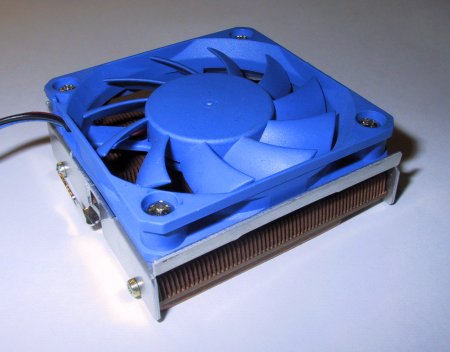
Who said that fans have to be black?
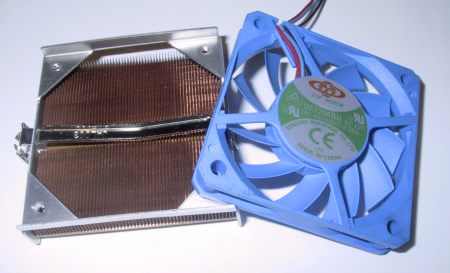
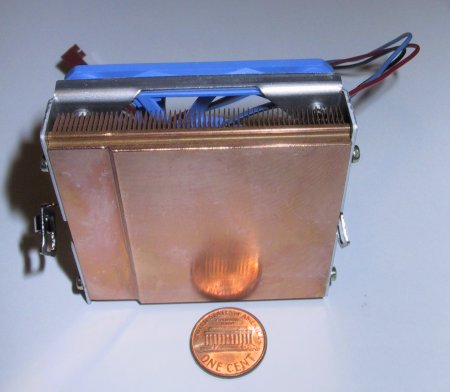
Installation
The CoolJag cooler comes with a standard clip, which is easy to install and
uninstall. Thermal compound is included. By default, the fan blows onto the
heatsink. It is not possible to reverse the fan, since the screws that hold
the fan are too short for this.
Performance and noise, conclusion
The performance of the CoolJag unit was the best of all 1U coolers tested here. However, under the conditions in a 1U server, the best performance is only reached if the fan is reversed, which is not possible with the supplied screws. We have contacted CoolJag about this issue, and they replied that other screws would be included in the future. So, if you plan to buy this cooler in order to use it in a 1U case, make sure you buy the version with the longer screws, or get other screws separately.
With high cooling performance comes high noise; the CoolJag cooler isn't
an exception - it is among the noisier coolers in this roundup. Still, it
is much quieter than recent high-performance coolers for desktop systems.
|
Cool Jag JAC-311C |
|
Fan: Top Motor 60x10mm, blue
|
| Advantages |
|
| Disadvantages |
|
Alpha PAL153U

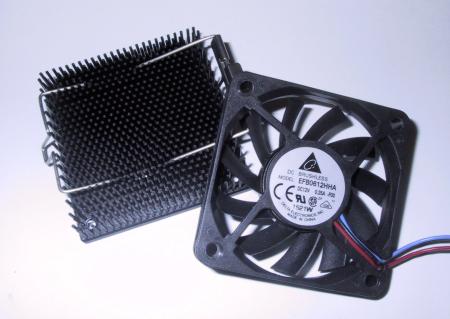
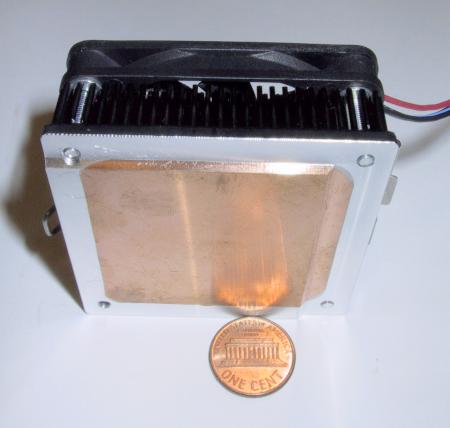
Installation
The PAL153U comes with a spring wire clip that is similar to the ones we've
seen on older Alpha coolers for Socket CPUs. Both installation and deinstallation
are easy, and the clip holds the heatsink firmly. Thermal compound is included.
The fan orientation can be chosen: If the fan should exhaust air from the
heatsink (better in a 1U environment), the included washers are placed between
fan and heatsink, so that the rotating fan blades don't touch the heatsink's
pins. If the fan should blow towards the heatsink, the washers should be placed
above the fan.
Performance and noise, conclusion
The Alpha PAL153U's performance is very good, but depends very much on the fan orientation. In a 1U environment, it is better to let the fan exhaust air from the heatsink; in other configurations where there is more space above the cooler (e.g. 2U+ servers), the fan should blow towards the sink. In any case, it is a good idea to compare temperatures in both configurations after installation, since it depends on many variables (such as ventilation concept of the case, location of air intakes) whilc configuration is better.
Of all coolers in this roundup, the PAL153U was only outperformed by the CoolJag unit.
As usual, cooling performance has its price, when it comes to noises: The
PAL153U was the second noisiest cooler in this roundup. Still, compared to
high performance desktop coolers, it's noise level is still bearable.
|
Alpha PAL8045 |
|
Fan: Delta 60x10mm
|
| Advantages |
|
| Disadvantages |
|
C&COM Tech S6612P-30CU
The second all-copper 1U cooler in this roundup comes from C&COM Tech. It uses a "folded fin" design, where the fins consist of a folded copper sheet that is soldered on a thicker copper base plate. There seems to be a version of this cooler with aluminum fins on a copper plate, which is advertised under the same model name on the C&COM Tech website. So beware that not all versions of this cooler are identical to the unit tested here.

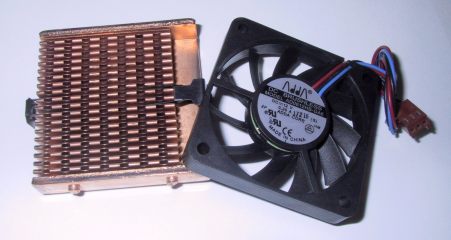
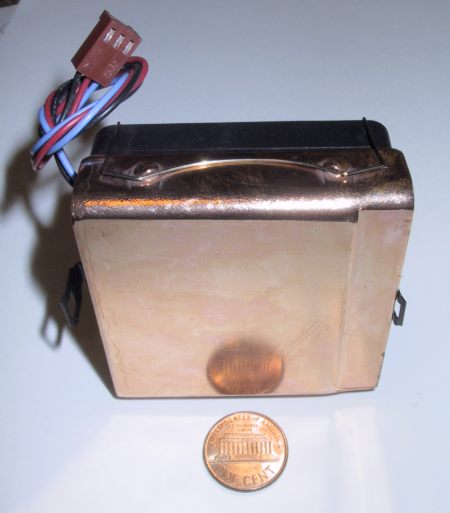
Installation
Installation is simple, but requires a screwdriver. The cooler's fan is mounted
using two spring clips. It is possible to reverse the fan, without any tools.
Performance and noise, conclusion
The C&C cooler's performs well, but not as good as its competitors from Alpha and CoolJag. As with all other coolers, its performance in a 1U environment is better when the fan exhausts air from the heatsink. Unfortunately, the C&C unit is the loudest of all coolers tested here.
| C&C |
|
Fan: ADDA 60x10mm
|
| Advantages |
|
| Disadvantages |
|
Thermaltake TFCF014-1
Thermaltake's 1U cooler is larger than most other 1U coolers, but consists only of aluminum.
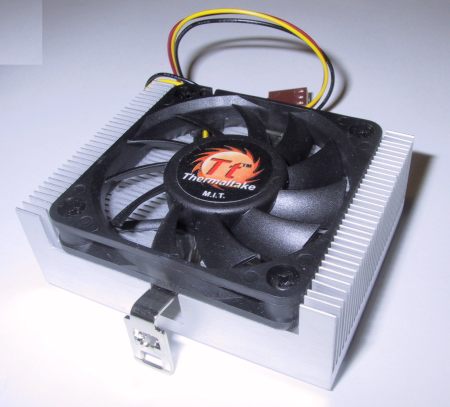
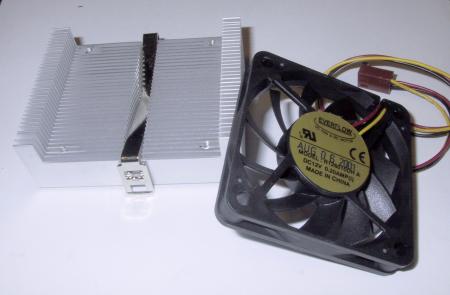
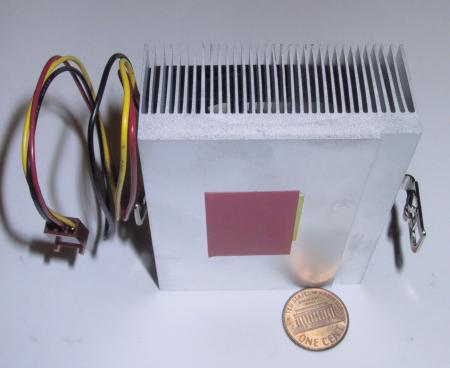
Installation
Installation of Thermaltake's TFCF014-1 cooler can be a bit tricky. Thermaltake
advertises this cooler only for use with Intel CPUs; it should, however, also
be suitable for AMD CPUs - provided that great care is being taken during
installation. A screwdriver is required. The cooler comes with a preinstalled
thermal pad; for testing we removed the pad and replaced it with thermal compound.
We'd recommend that you do the same for better cooling performance. On their
website,
The cooler's fan blows towards the heatsink. Reversing the fan is not possible,
because the screws are too short, and additional washers would be required
- otherwise the fan blades spin dangerously close to the heatsink's fins.
Performance and noise, conclusion
Thermaltake's cooler performs rather well, especially considering that this is an all-aluminum solution. As all other coolers, it performs better under 1U conditions if the fan exhausts air from the heatsink (which isn't possible with the supplied screws). If the manufacturer does something about this problem, then we'll definitely recommend this cooler, since it is inexpensive and also among the quietest coolers in this roundup.
| Thermaltake TFCF014-1 |
|
Fan: Everflow 60x10mm
|
| Advantages |
|
| Disadvantages |
|
Spire 5R52B3
The first thing we noticed about Spire's 1U cooler is that it looks very similar to the Thermaltake unit also present in this roundup.
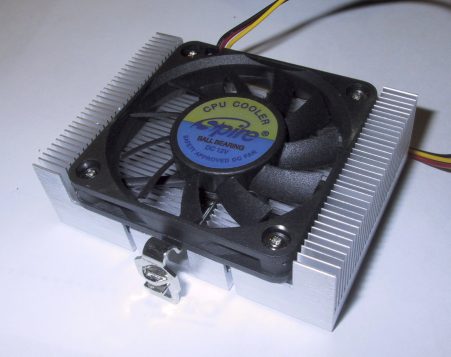
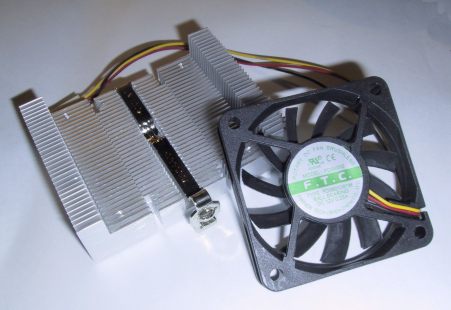
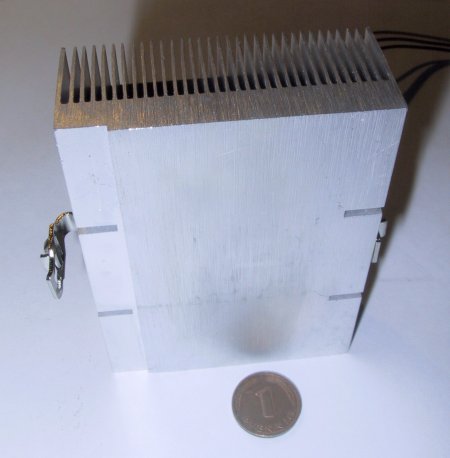
Installation
Installation is a bit tricky; a screwdriver is required. A thermal pad is
included; for our tests we removed the pad and used thermal compound instead.
The Spire cooler has the same problem as the Thermatake unit: The fan cannot
be reversed, unless other screws and additional washers are being used.
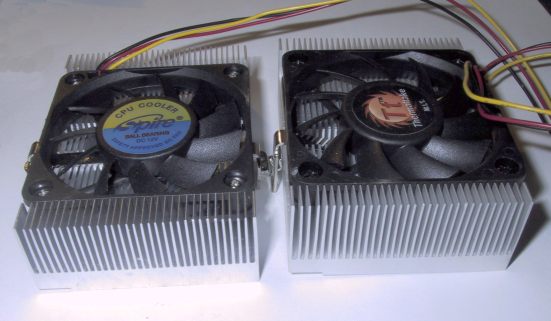
The Spire and Thermaltake coolers side by side: Similar, but
not identical.
Performance and noise, conclusion
Despite the similarity, the Spire cooler doesn't perform as well as the Thermaltake cooler. Possible reasons for this include the surface finish (which is better on the Thermaltake unit), the clip or the fan. As usual, the Spire cooler performs better in 1U conditions when the fan is reversed, which is not possible with the screws the cooler comes with.
The advantages: The 5R52B3isn't very loud, and while we don't recommend it for AMD CPUs with high power dissipation, it should be suitable for all Socket 370 CPUs. Being made entirely of aluminum, it isn't too expensive either.
| Spire |
|
Fan: Proprietary 60x10mm
|
| Advantages |
|
| Disadvantages |
|
TennMax Max7
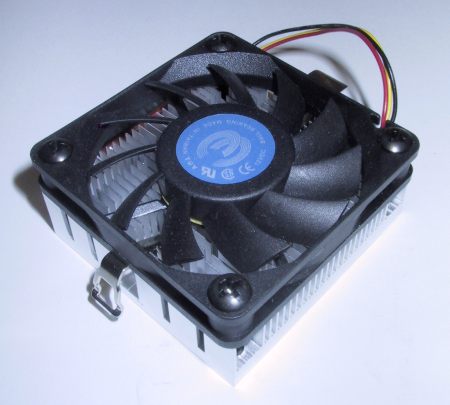
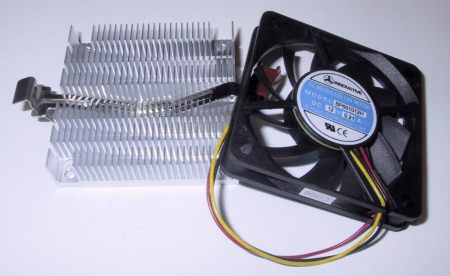
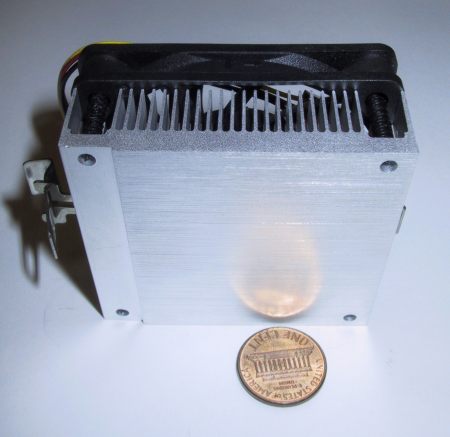
Installation
Installation is easy, no tools are required. The TennMax Max7 is particularly
small, so it fits even boards that have components very close to the CPU socket.
Performance and noise, conclusion
While the size/performance ratio of the Max7 cooler tested here is good, it isn't particular astonishing or innovative by design. We received more interesting samples from TennMax:
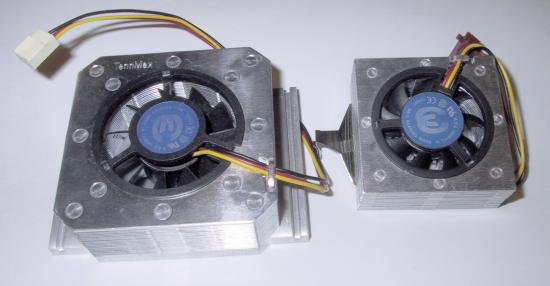
These are other samples TennMax supplied, using their "Lasagna"
technology. The super-compact Lasagna on the right didn't perform as well
as its much larger brother with a classical design, the Max7 reviewed here.
The large Lasagna cooler, on the left, is only suitable for P4/Xeon CPUs.
So, the only TennMax cooler included in this roundup is the Max7.
The Max7 tested is suitable for Celeron and most P3 CPUs; we don't recommend it for AMD Athlon CPUs with higher power dissipation.
As with all other 1U coolers, the performance is better in 1U conditions if the fan is reversed. The supplied screws allow you to reverse the fan.
| TennMax Max7 |
|
Fan: Innovative 60x10mm
|
| Advantages |
|
| Disadvantages |
|
Thermaltake Low Profile Orb
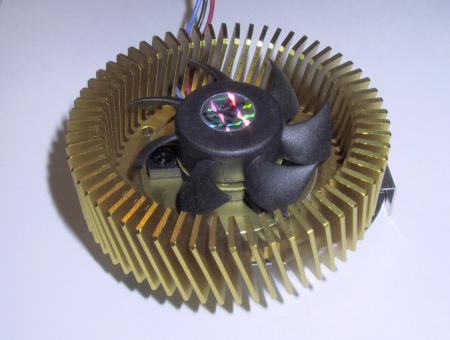
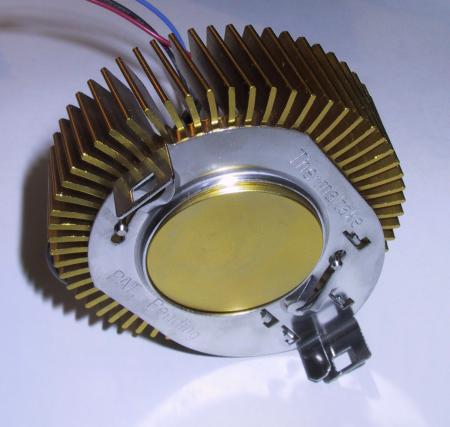
Installation
The Low Profile Orb uses the same twist-on clip as the first generation "Golden
Orb". This makes the cooler incompatible with AMD CPUs, since the core of
these CPUs could be damaged during installation. However, the Low Profile
Orb would fit our simulator device without problems.
The Low Profile Orb comes with a preinstalled thermal pad, which we removed
and replaced by thermal compound. The fan, which is integrated into the heatsink,
cannot be reversed.
Performance and noise, conclusion
The performance of the Low Profile Orb was very deceiving. Why? At first we thought the heat transfer between our simulator and the cooler might be the problem, since the simulator simulates an AMD CPU (for which the Low Profile Orb isn't designed). However, upon further investigation, we noticed that during operation, the center of the heatsink was very hot, while the fins stayed relatively cool. So the real reason for the Low Profile Orb's poor performance seems to be the bad thermal transfer within the heatsink - no wonder, since the contact area between fins and base is very small, and there is no copper involved. Because of this design flaw, we expect that the cooler doesn't perform too well when used with an Intel CPU either.
We did not test this cooler in an 1U environment, since the temperature reached by the simulator during the "open space" test was already so high that we feared that the simulator wouldn't survive the 1U test with this cooler.
On the bright side, the Low Profile Orb was the quietest cooler in this roundup. Therefore, we recommend the Low Profile Orb only for applications where a CPU with very low power dissipation is being used, and where low noise is more important than good cooling performance.
| Thermaltake |
|
Fan: Proprietary, integrated
|
| Advantages |
|
| Disadvantages |
|
Spire 5E198B1H3R
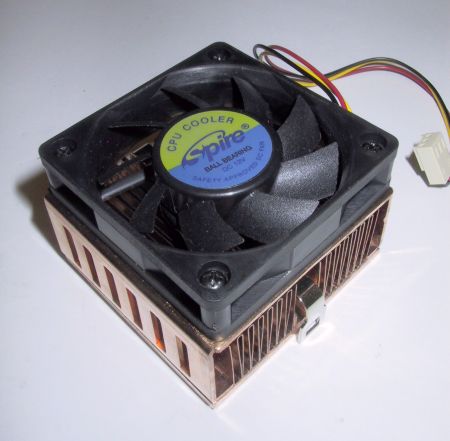
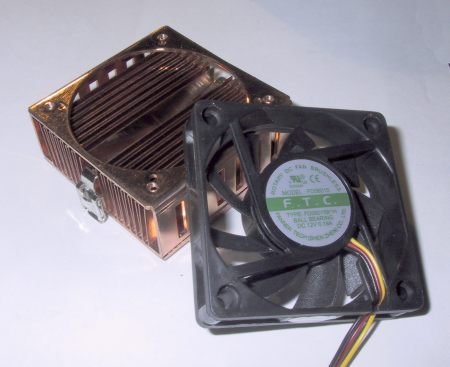
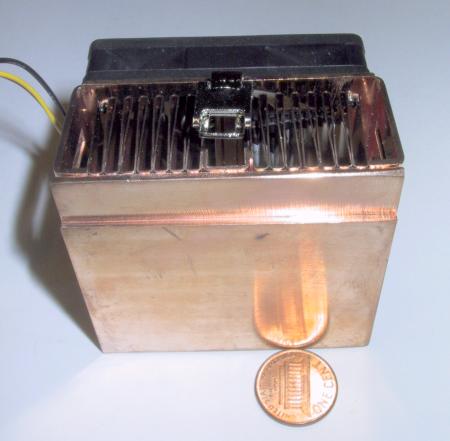
Installation
Installation is easy; a screwdriver is required. The cooler ships with thermal
compound. Reversing the fan isn't possible since the screws are too short;
however that shouldn't be necessary in a 2U case.
Performance and noise, conclusion
When it comes to size and performance, Spire's cooler for 2U cases is comparable to desktop cooling solutions. It does show the obvious - that a 2U case allows the usage of more efficient CPU coolers. Provided that the case cooling is good enough, this cooler should be suitable even for the Athlon XP 1700+.
Keep in mind that when you're using a 2U case, there's also lots of other choices - you can, for example, use a good heatsink designed for normal desktop systems (such as the Thermalright SK6), and install a compact 60x10mm fan on it.
| Spire |
|
Fan: Proprietary 60x15mm
|
| Advantages |
|
| Disadvantages |
|
Final Words
There are two 1U coolers we particularly recommend: the Alpha PAL153U, and the CoolJag JAC311C. The CoolJag performed the best; however, the current version doesn't ship with screws suitable for reversing the fan - which is necessary in a 1U environment in order to reach best possible performance. The Alpha PAL153U doesn't have this problem, and still provides excellent performance.
One thing many are probably wondering about is: "For which CPUs exactly will these coolers be sufficient?". There is no general answer to this question. On a 1U system, more than on a larger desktop PC, the efficiency of the CPU cooling depends greatly on the overall ventilation concept of the case. So, without considering the case cooling, it is not possible to say which cooler will be sufficient for which CPU. Even if you chose a good cooler, extensive testing and thermal monitoring of the server should be done before using the machine in a production environment.
There's one thing we can say for sure: You cannot buy any generic 1U case,
good heatsinks, and build an AMD dual CPU system based on this. Using AMDs high-end
CPUs, especially in a dual CPU configuration, requires an overall case cooling
concept that is well-thought out - good heatsinks alone aren't sufficient. An
example for an overall cooling concept that is well thought out is
APPRO's 1124 760MP Server.
Manufacturer links
Alpha - www.alphanovatech.com
C&COM Tech - www.ccomtech.com
CoolJag - www.jagwire.com.tw
Spire - www.spirecoolers.com
TennMax - www.tennmax.com
Thermaltake - www.thermaltake.com provided by Frozen Silicon & The Card Cooler







